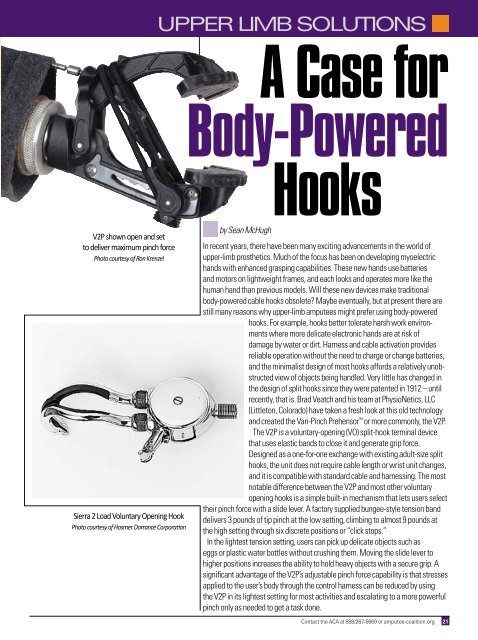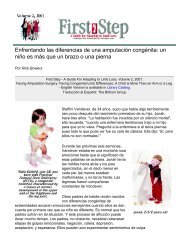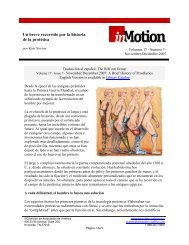A Case for Body-Powered Hooks - Amputee Coalition
A Case for Body-Powered Hooks - Amputee Coalition
A Case for Body-Powered Hooks - Amputee Coalition
Create successful ePaper yourself
Turn your PDF publications into a flip-book with our unique Google optimized e-Paper software.
Upper Limb SolutionsA <strong>Case</strong> <strong>for</strong><strong>Body</strong>-<strong>Powered</strong><strong>Hooks</strong>V2P shown open and setto deliver maximum pinch <strong>for</strong>cePhoto courtesy of Ron KrenzelSierra 2 Load Voluntary Opening HookPhoto courtesy of Hosmer Dorrance Corporationby Sean McHughIn recent years, there have been many exciting advancements in the world ofupper-limb prosthetics. Much of the focus has been on developing myoelectrichands with enhanced grasping capabilities. These new hands use batteriesand motors on lightweight frames, and each looks and operates more like thehuman hand than previous models. Will these new devices make traditionalbody-powered cable hooks obsolete? Maybe eventually, but at present there arestill many reasons why upper-limb amputees might prefer using body-poweredhooks. For example, hooks better tolerate harsh work environmentswhere more delicate electronic hands are at risk ofdamage by water or dirt. Harness and cable activation providesreliable operation without the need to charge or change batteries,and the minimalist design of most hooks af<strong>for</strong>ds a relatively unobstructedview of objects being handled. Very little has changed inthe design of split hooks since they were patented in 1912 – untilrecently, that is. Brad Veatch and his team at PhysioNetics, LLC(Littleton, Colorado) have taken a fresh look at this old technologyand created the Vari-Pinch Prehensor or more commonly, the V2P.The V2P is a voluntary-opening (VO) split-hook terminal devicethat uses elastic bands to close it and generate grip <strong>for</strong>ce.Designed as a one-<strong>for</strong>-one exchange with existing adult-size splithooks, the unit does not require cable length or wrist unit changes,and it is compatible with standard cable and harnessing. The mostnotable difference between the V2P and most other voluntaryopening hooks is a simple built-in mechanism that lets users selecttheir pinch <strong>for</strong>ce with a slide lever. A factory supplied bungee-style tension banddelivers 3 pounds of tip pinch at the low setting, climbing to almost 9 pounds atthe high setting through six discrete positions or “click stops.”In the lightest tension setting, users can pick up delicate objects such aseggs or plastic water bottles without crushing them. Moving the slide lever tohigher positions increases the ability to hold heavy objects with a secure grip. Asignificant advantage of the V2P’s adjustable pinch <strong>for</strong>ce capability is that stressesapplied to the user’s body through the control harness can be reduced by usingthe V2P in its lightest setting <strong>for</strong> most activities and escalating to a more powerfulpinch only as needed to get a task done.Contact the Aca at 888/267-5669 or amputee-coalition.org 21
“We believe this innovation will particularlybenefit bilateral amputees who tendto favor body-powered systems and whoare most at risk <strong>for</strong> repetitive stress injuriesand fatigue,” says Veatch. If even greater<strong>for</strong>ce is needed, additional bungee bandsor common office-supply rubber bandscan be easily applied or removed withouta special tool or a trip to the prosthetist’soffice. This ability to change bands withoutassistance should prove especially helpful <strong>for</strong>those who live in remote regions without easyaccess to an O&P provider.There are three other body-powered hooks onthe market that offer a choice of two selectablepinch <strong>for</strong>ce levels. The Sierra 2 Load Voluntary Opening Hook fromHosmer Dorrance Corporation (hosmer.com) permits pre-selection ofpinch <strong>for</strong>ce equal to 3.5 pounds or 7 pounds through a load selectorbutton on the thumb. Otto Bock HealthCare (ottobockus.com) makestwo versions of their Standard Two-Load Hook, which uses tensionsprings and a thumb lever selector to choose between a light or heavypinch <strong>for</strong>ce. Each version has a slightly different hook finger shape.I did not have the opportunity to test the Hosmer or Otto Bock hooksprior to writing this review of the V2P, but I would welcome the chanceto do so in the future.While similar in shape, length, weight and connection hardwareto a traditional farmer’s hook, the V2P incorporates some significantThe Otto Bock Standard Two-Load HookA flick of the small lever (usually done bybrushing against the leg) lets you selectbetween two different pinch <strong>for</strong>cesPhoto courtesy of Otto Bock HealthCaredifferences. Tension bands are strungacross the opening area of the hook,and while I expected them to get in theway of grasping large objects, I foundinstead they provide additional stabilityand some shock absorption, especiallywhen handling yard and garden tools. Thehook itself has a much beefier profile thanstandard hooks, and its extra surface areaadds stability when holding objects suchas drinking glasses or bottles. Replaceableelastic fingertips can be put on or removedeasily as needed to give firm, positive grip <strong>for</strong>slippery objects.I found these fingertips useful <strong>for</strong> pickingup coins, handling office papers and turning book pages. They alsoprovide a friendlier, scratch-free interface with the steering wheeland radio controls in my car. Rugged activities can make the fingertipscome off, and so, after searching through the garden to find them acouple of times, I recommend taking them off prior to shoveling, raking,etc.I find the V2P to be a welcome addition to my prosthetic toolbox.It comes in engineering polymer, aluminum and stainless steelversions, and can be purchased directly from PhysioNetics atphysionetics.org. Upper-Limb Perspectives is a column written by members of theACA’s Upper Limb Loss Advisory Council.






